|
Author
|
Topic: Apollo 11 artifacts in private space collections
|
p51
Member Posts: 1722
From: Olympia, WA
Registered: Sep 2011
|
 posted 12-04-2012 09:57 PM
posted 12-04-2012 09:57 PM
   
Keep in mind, there are collectors that keep their stuff a total secret and are NOT known among the space collecting community at all (or anyone else for that matter). It's a shame how much stuff that is hidden away by private collectors that nobody knows of.I know for sure of some pretty impressive Apollo 11 stuff in a private collection of a pal of mine that I had no idea he collected space stuff at all until I accidentally opened the wrong door in his place looking for the bathroom. My jaw hit the floor when I saw just a peak at a room filled with Apollo stuff. Not even anyone here would know this guy, I don't think his own family knows what he has, will come as one heck of a shock when he passes on someday (don't even think to ask the obvious question on that point, this guy is young). Just saying, if there's one collector out there like that for sure, there's gotta be more of them. |
fredtrav
Member Posts: 1760
From: Birmingham AL
Registered: Aug 2010
|
 posted 12-05-2012 12:11 AM
posted 12-05-2012 12:11 AM
   
What is even worse, when these people pass on if they have not let anyone know what they have, it could be thrown out. I shudder to think of the NASA awards and other items discarded by clueless family members after a loved one has died and they are cleaning up. |
Jurvetson
Member Posts: 125
From: Los Altos an SF, CA, United States
Registered: Sep 2011
|
 posted 12-26-2012 02:03 AM
posted 12-26-2012 02:03 AM
   
I am curious about the data clip from Eagle. Perhaps I skimmed too quickly here, but I have not seen any other part of Eagle that has been brought back. I have a particular fascination with Lunar Module hardware, especially if flown to the moon. Documents, personal tools and food, PPK items and souvenirs are not part of the spacecraft, so I still wonder, what else from Eagle's ascent stage still exists today? Background: I started collecting space artifacts three years ago, when I found the COAS from Orion up for auction and my jaw dropped. I have since found LM hardware from Apollo 10, Apollo 15 and Apollo 16. But Apollo 11 is special, for so many reasons. Beyond the historic significance, it was a short and scripted mission. NASA ordered most of command module Columbia to be retained intact, and Neil Armstrong pledged his mementos to museums, so that leaves Buzz Aldrin and his data clip in a unique position or am I missing something? |
SpaceAholic
Member Posts: 4885
From: Sierra Vista, Arizona
Registered: Nov 1999
|
 posted 12-26-2012 07:27 AM
posted 12-26-2012 07:27 AM
   
Of course the returned ALSRC's were LM "unique" as were some of the film magazines, and deco bag. With those exceptions, almost everything that came back were personal or crew operational aids (clips and checklists are binned in this category) — unaware of any components returned from Eagle's ECS, Structural, Telecon, G&N, G&C, EPS, Nav, Docking, Control/Display or Prop/RCS systems. |
Robert Pearlman
Editor Posts: 46573
From: Houston, TX
Registered: Nov 1999
|
 posted 12-26-2012 07:55 AM
posted 12-26-2012 07:55 AM
   
A pulley clamp was returned from Eagle that was then used in the creation of the Apollo 11 Manned Flight Awareness medallions. Whether the full clamp was smelted, or if part of it still exists today (somewhere), I don't know. |
spaced out
Member Posts: 3165
From: Paris, France
Registered: Aug 2003
|
 posted 12-26-2012 11:23 AM
posted 12-26-2012 11:23 AM
   
quote:
Originally posted by Jurvetson:
...so that leaves Buzz Aldrin and his data clip in a unique position or am I missing something?
Steve, while it's a great item, I'm not sure I entirely follow your definition of "hardware" as applied to this clip versus other items of flown memorabilia returned from Eagle.The data clip was never an integral piece of the lunar module, just a piece of equipment stowed there for use by the crew. I don't see the real difference between the clip and the flight plans (and other items) that it was intended to hold in place, unless it's the fact that the clip is made of metal. But in that respect metal items of equipment used by the crew should also count as "hardware," e.g. the LM spoon stowed for Aldrin's use in the LM at launch. That too was "officially" scheduled to be left behind on the LM rather than returned as a souvenir. |
Jurvetson
Member Posts: 125
From: Los Altos an SF, CA, United States
Registered: Sep 2011
|
 posted 12-26-2012 07:59 PM
posted 12-26-2012 07:59 PM
   
I hear you; it might seem like splitting hairs. But it also speaks to the stories and motivation for collecting. Talking through this helps clarify my thinking on why I am attracted to certain items, and have little interest in others.When I wonder if it's possible to collect something from a historic spacecraft like Eagle, there are some items that I would regard as part of the spacecraft and some that are cargo or personal items of the astronaut. Perhaps the distinguishing difference would be whether those specific items would have naturally flown with the astronauts on any lunar landing mission, whether or not it was the LM as we know it. (Were they part of the LM design? Was their functionality integral to the spacecraft? Do they need to be attached to the spacecraft to do their job?) So cutlery, pens, flashlights, toothbrushes, and PPKs seem like personal items. The "spacecraft hardware" had to be detachable to survive, yes? For Apollo in general, I would include the LM COAS, light and data clip for example. If I am not mistaken, all three of these items are functional when attached to the spacecraft, and generally useless if not. The data clip has an attach point to snap onto the LM; its function is to hold the data cards in place during the mission for data transcription. (I believe the COAS and data clip could be used in either the CM or LM, but each spacecraft had differently marked versions, and the flight plan did not call for a transfer of them through the hatch.) So the ALSRC would also be spacecraft hardware, and a special sub-category perhaps since it's a cargo container that's meant to be brought back. I notice that it is in the National Air and Space Museum's inventory of Apollo 11 artifacts (a fun list, with "Command Module" mixed in there. I see a number of CM items, but did not notice other items from Eagle (as I try to define it) from a quick skim). As an aside, I notice that this list of Apollo 11 artifacts has no documents (they are in a separate "archives" division). Is that common nomenclature? |
SpaceAholic
Member Posts: 4885
From: Sierra Vista, Arizona
Registered: Nov 1999
|
 posted 12-26-2012 10:54 PM
posted 12-26-2012 10:54 PM
   
The National Air and Space Museum list only reflects Apollo 11 artifacts which were handed off by Johnson Space Center or donated to the Smithsonian (further reduced by those artifacts in the museum's inventory which it has not placed online; there are many of its holdings which are not detailed online). |
spaced out
Member Posts: 3165
From: Paris, France
Registered: Aug 2003
|
 posted 12-27-2012 08:38 AM
posted 12-27-2012 08:38 AM
   
Steve, In the end I have to agree that in the category of items defined arbitrarily by yourself to explicitly exclude all items that are not the item you have, your item is indeed unique.  |
Jurvetson
Member Posts: 125
From: Los Altos an SF, CA, United States
Registered: Sep 2011
|
 posted 12-27-2012 11:57 AM
posted 12-27-2012 11:57 AM
   
I must admit I am biased, yes, but I am by no means trying to exclude other items. I was trying to add clarity to my earliest question – what parts of the Eagle spacecraft were brought back? The ALSRC and melted pulley clamp are good examples. I would love to hear of others.My definition is an attempt to be more precise about something that seems intuitively obvious to me. A toothbrush is not a piece of the Eagle spacecraft in my mind, but the COAS is. If so, then how do we make that distinction? I started with your tip: is the functionality integral to the spacecraft? I added some other filters. Perhaps someone else has already gone through this exercise? And I don't mean to imply any demeaning of the collectability of other items. I'm sure there are many collectors who cherish the historic documents with the writing of the astronauts, or those embedded with lunar surface dust, or flown memorabilia across missions. I'm also sure that many collectors would look right past a small clip of metal as an insignificant trifle (like collecting the rings holding the documents together rather than the documents themselves). My curiosity around what has been brought back from the spacecraft relates to the unique challenges of their survival, and thus, the rarity of those items.
|
SpaceAholic
Member Posts: 4885
From: Sierra Vista, Arizona
Registered: Nov 1999
|
 posted 12-27-2012 12:20 PM
posted 12-27-2012 12:20 PM
   
With the exception of a limited number of functions performed by the sequential subsystem, the LM was not autonomous. Humans were integral as a subsystem to operate the vehicle and execute the mission.It follows that the majority of crew operational aids and some personal items were therefore an integral part of the LM if their removal degraded or prevented a successful outcome. |
Jurvetson
Member Posts: 125
From: Los Altos an SF, CA, United States
Registered: Sep 2011
|
 posted 12-27-2012 03:59 PM
posted 12-27-2012 03:59 PM
   
I can't tell if you guys are goofing on me or trying to refine a good definition of "the Eagle spacecraft." While there is logic to the man-machine dyad, we all know the mission would have proceeded just the same without a toothbrush. And nobody walked up to Neil or Buzz and thought "What a great honor to speak with the lunar module."  So, with an appeal to a definition that jives with common sense interpretations, perhaps we should anchor on the primary function of the subcomponent, and whether its design and function is integral to the spacecraft, and it would typically be used only in that context? |
spaced out
Member Posts: 3165
From: Paris, France
Registered: Aug 2003
|
 posted 12-27-2012 04:09 PM
posted 12-27-2012 04:09 PM
   
Without the documentation they certainly wouldn't have been able to carry out the mission.Without the food packages they probably wouldn't have been able to do it either. Without at least one of their pairs of scissors they wouldn't have been able to open the food packets to eat. Without pens and pencils they wouldn't have been able to make vital notes and updates to plans etc as the mission progressed. On the other hand, without a data clip they might well have been able to get by, just as they could have gotten by without a toothbrush or sunglasses. It would have been annoying and awkward for sure but not a show stopper. I'm not trying to talk down the item here. It's a great souvenir of a great mission. I just don't see it as a piece of the Eagle, or in some way more mission-critical or functionally important than other items of equipment (as opposed to PPK items) returned from the LM. |
Jurvetson
Member Posts: 125
From: Los Altos an SF, CA, United States
Registered: Sep 2011
|
 posted 12-27-2012 04:56 PM
posted 12-27-2012 04:56 PM
   
So we are in complete agreement that whether something is essential to the mission is a completely unrelated issue, and does not relate to the definition of the spacecraft. The humans themselves, the oxygen they breathe and food are all in that bucket. I did not suggest that was part of the definition. Perhaps you could suggest a better definition to help me out here. Do you agree that the ALSRC and COAS are part of the spacecraft? Is there anything else that has come back from Apollo missions that you would regard as part of the lunar module? Perhaps by inclusion, I can better understand what if anything is a grey area and what is clearly a part of Eagle. Perhaps an analogy might help. Some of the astronauts also drove Corvettes. If someone wanted to collect a vintage car like that, I'm guessing the definition of the "car" would not be a subject of much disagreement. The driver is clearly not part of the car even though the car is useless without the driver. One could argue about the license plate and registration papers (can't drive without them, but it's clearly still a Corvette without them). Same for the gas, sunglasses, and food for the trip. I hope it is obvious that none of these are part of what we think of as the Corvette. If this analogy helps, it does suggest that if someone wanted to collect the complete vintage car, they might want to see the original specialty tools included (dedicated elements like tire jack and spare tire). I would think those items are part of the car because their function is defined in the context of the car, and they are attached to the car when performing their designed function. And they are typically not used elsewhere. If that makes sense so far, it seems like the same common sense definition could apply to "the spacecraft" as "the car." |
SpaceAholic
Member Posts: 4885
From: Sierra Vista, Arizona
Registered: Nov 1999
|
 posted 12-27-2012 05:33 PM
posted 12-27-2012 05:33 PM
   
Every item carried outside the confines of a PPK (except O2 molecules) bore a specification number exclusively applicable to the LM/CM operational environment (the specification number defined design and fabrication parameters)... even pens and toothbrushes. From that perspective they are spacecraft unique. |
Greggy_D
Member Posts: 997
From: Michigan
Registered: Jul 2006
|
 posted 12-27-2012 07:19 PM
posted 12-27-2012 07:19 PM
   
Steve, what a great artifact you have there. You are extremely fortunate to have been "chosen" to be the clip's current custodian. It's nice to know that it went to a good home where it will be cared for, even decades from now.Having said that, personally I do not consider your clip as being a part of Eagle. If you will, allow me to introduce this analogy. I have a Flight Data File (FDF) from STS-61B. Stripping down the FDF, we are left with two velcro covered plastic covers and three metal rings. Now what is the purpose of this cover? To keep the FDF organized and together and also, to keep the FDF stationary and readily accessible by the astronauts. The exact same purpose as your Apollo 11 clip. Never in a million years would I consider the above cover a "part" of Atlantis. It's a tool or utility, but not an official shuttle hardware part. All in all, this is an interesting discussion gentlemen. |
Hart Sastrowardoyo
Member Posts: 3452
From: Toms River, NJ
Registered: Aug 2000
|
 posted 12-27-2012 07:31 PM
posted 12-27-2012 07:31 PM
   
So if a screw holding a panel can be removed without the panel going kaflunky, that screw wouldn't be considered a part of the spacecraft? |
Robert Pearlman
Editor Posts: 46573
From: Houston, TX
Registered: Nov 1999
|
 posted 12-27-2012 07:33 PM
posted 12-27-2012 07:33 PM
   
Unless the clip was part of Grumman's design spec for the lunar module, then I would say it was not part of Eagle. It flew on Eagle and served a specific purpose to the Apollo 11 mission, but wasn't part of the spacecraft. |
Greggy_D
Member Posts: 997
From: Michigan
Registered: Jul 2006
|
 posted 12-27-2012 07:37 PM
posted 12-27-2012 07:37 PM
   
Exactly. quote:
Originally posted by Hart Sastrowardoyo:
So if a screw holding a panel can be removed without the panel going kaflunky, that screw wouldn't be considered a part of the spacecraft?
Hart, yes I would consider the screw a part of the LM. I'm sure it shows up on some engineering schematic. The clip would not (my guess). |
SpaceAholic
Member Posts: 4885
From: Sierra Vista, Arizona
Registered: Nov 1999
|
 posted 12-27-2012 08:02 PM
posted 12-27-2012 08:02 PM
   
quote:
Originally posted by Robert Pearlman:
Unless the clip was part of Grumman's design spec for the lunar module, then I would say it was not part of Eagle.
Knew someone would go down that road.  Yes, one could settle on that as the governing criteria, i.e. the component is only LM integral if umbrelled under an LSP but that would also mean items like the COAS (which does not have a Grumman drawing number) are non-organic to the spacecraft. |
space1
Member Posts: 893
From: Danville, Ohio
Registered: Dec 2002
|
 posted 12-27-2012 08:05 PM
posted 12-27-2012 08:05 PM
   
I would say that there are parts of the spacecraft, and there are stowage items. A pouch attached to the LM bulkhead would be part of the LM, but its contents would not. They would be stowage items.Are the stowage items important and interesting? Absolutely. In many cases they would even be mission critical. They had to be since every ounce of weight on the LM was carefully evaluated. If it wasn't needed it wasn't included. Regarding Eagle, I don't know if the astronauts removed the types of items that other crews removed. From other lunar missions we have seen at auction or in museums items such as the LM COAS, spare COAS lamps, COAS mount cover, armrests, netting, pouches, 16mm camera, portable lights, cables for the camera and lights, window shades, rotation controls, hatch tool (to unlock the CM hatch during emergency EVA), and water gun. I'm probably missing something, but you get the idea. |
Jurvetson
Member Posts: 125
From: Los Altos an SF, CA, United States
Registered: Sep 2011
|
 posted 12-28-2012 01:48 AM
posted 12-28-2012 01:48 AM
   
Thank you. That is exactly what I was trying to get to with my line of questions. I wonder if any of those types of items were brought back from Eagle. I have not noticed any of those from Apollo 11.Robert/Scott: I like that “design spec” notion as a possible defining element of what it means to be part of the spacecraft. Surely, each part of the spacecraft would be in the design somewhere, and the meaningful subcomponents would have part numbers, even if they had company affiliations other than Grumman, yes? The COAS was an essential component of the LM as it was needed for docking and mounts to the LM window frame — like the data clip mounts to the AOT frame — both have LM fixtures made for their attach points. (Not sure if someone is proposing a definition of the LM that excludes the COAS, but that would be like excluding the rear-view mirror from the Corvette by the analogy I tried to suggest above.) So, does this design spec definition align with common sense? It would suggest that the screws are part of the spacecraft design spec, but documents are not. (Greggy, looking beyond Apollo, some checklists had Velcro and some had plastic covers… and sometimes those covers became mission critical, as with the Apollo 13 LM scrubber, but I’m guessing that your intuition is right that they are not commonly regarded as a piece of the spacecraft, and the spacecraft designers probably shared that notion and did not design the covers, and did not put part numbers on the plastic sheets you show there). |
chet
Member Posts: 1513
From: Beverly Hills, Calif.
Registered: Nov 2000
|
 posted 12-28-2012 02:50 AM
posted 12-28-2012 02:50 AM
   
It would seem to me that Steve is simply asking about "parts of Eagle" where the definition of such is anything that was, as of mission commencement, attached or affixed to the spacecraft (as alluded to nicely by John ["space1"]).With that as a rudimentary definition, it does indeed seem hard to come up with additional examples of such items that made it back to Earth. |
space1
Member Posts: 893
From: Danville, Ohio
Registered: Dec 2002
|
 posted 12-28-2012 05:03 AM
posted 12-28-2012 05:03 AM
   
From the "design spec" point of view, we could consider Grumman part numbers (LDW, which are structural parts, pouches, armrests, and other Grumman-made items), Grumman specs (LSC, which are sub-components made by subcontractors to Grumman requirements such as switches, knobs, valves, LiOH canisters, etc.), and other contractor specs (North American Aviation: ME, such as the COAS). Most of the stowage items were NASA JSC parts (SED), including off-the-shelf items approved for flight, such as pens. I don't know of any LM structural items that would have been JSC parts. But some stowage items were Grumman specified, such as urine bags. And the hatch tool is a stowage item made by NAA with a "V36" command module part number. As the astronauts had only a few minutes in which they could remove extra items from the LM (I have read it was something like four minutes), they could only retrieve the most portable of items. The armrests were removable, so they may have been the most portable structural component ("LDW"). The utility light clamps and temporary stowage bag were also "LDW" parts and quite portable. The rotation controls could be removed with some effort. Some items simply had to be un-clamped (camera, utility lights, etc.). |
SpaceAholic
Member Posts: 4885
From: Sierra Vista, Arizona
Registered: Nov 1999
|
 posted 12-28-2012 07:13 AM
posted 12-28-2012 07:13 AM
   
quote:
Originally posted by chet:
It would seem to me that Steve is simply asking about "parts of Eagle" where the definition of such is anything that was, as of mission commencement, attached or affixed to the spacecraft (as alluded to nicely by "space1").
The clip was not attached or affixed to the spacecraft at launch...it was one of four "stowed" per the ASL with the Data Card Kit and available for optional crew deployment. |
spaced out
Member Posts: 3165
From: Paris, France
Registered: Aug 2003
|
 posted 12-28-2012 08:50 AM
posted 12-28-2012 08:50 AM
   
I believe I've found a reference to the clip in the mission transcripts: [Aldrin] (Voice cracking with nervousness) Houston, we have a problem.[Duke, Capcom] Copy Eagle. Can you clarify? [Aldrin] We've just discovered that a piece of the Eagle is missing. [Capcom] Eagle, can you repeat? [Aldrin] It's part of the Eagle. I repeat. Part of the Eagle is missing! [Armstrong to Aldrin] Is this about that darn clip? [Capcom] Eagle, you've got a bunch of guys about to turn blue down here. What part is missing? [Aldrin] It's a data file clip. Repeat, data file clip. [Aldrin to Armstrong] Stand by for abort. [Armstrong to Aldrin] Are you [garbled] kidding me? [Capcom] (laughter in background) Eagle, did you say a data file clip? [Aldrin] Roger that, Houston. I can't find the data file clip. [30 seconds pass] [Capcom] (transmission difficult to make out over background laughter) Eagle, the backroom boys tell me we are GO for Landing despite the Data File Clip loss. Repeat GO for landing. [Armstrong to Aldrin] I told you it wasn't part of the Eagle. [Aldrin] Wait. Here it is!  |
chet
Member Posts: 1513
From: Beverly Hills, Calif.
Registered: Nov 2000
|
 posted 12-28-2012 09:50 AM
posted 12-28-2012 09:50 AM
   
quote:
Originally posted by SpaceAholic:
The clip was not attached or affixed to the spacecraft at launch... it was one of four "stowed" per the ASL with the Data Card Kit and available for optional crew deployment.
Hard to see then how the clip could in any way be classified as "part of the Eagle." Still, a really nice hardware item that made it to Tranquility Base and back to Earth, so a rarity indeed no matter how you slice it. |
Larry McGlynn
Member Posts: 1338
From: Boston, MA
Registered: Jul 2003
|
 posted 12-28-2012 11:31 AM
posted 12-28-2012 11:31 AM
   
Does anybody remember the Apollo 11 CM hand rail that sold at a 2000 Butterfield's Auction? The handrail was removed from Columbia by NASA and deeded to a medical institute for study. Robert even reported on it back in the day. NASA investigated the sale and found that they had indeed given the spacecraft part to the foundation and allowed the sale. It sold for $35,000 back in 2000. Now that's a real spacecraft part with excellent provenance. I wonder where it went? Steve, you acquired a rare and wonderful Apollo 11 artifact for your collection. I hope it made for a Merry Christmas. Anybody who has a flown artifact from Apollo 11 has a great addition to their collection. To paraphrase the Most Interesting Man in the World, "Stay collecting my friends." |
Jurvetson
Member Posts: 125
From: Los Altos an SF, CA, United States
Registered: Sep 2011
|
 posted 12-28-2012 12:48 PM
posted 12-28-2012 12:48 PM
   
Thanks Larry! Will do. quote:
Originally posted by chet:
Steve is simply asking about "parts of Eagle" where the definition of such is anything that was, as of mission commencement, attached or affixed to the spacecraft (as alluded to nicely by "space1").
Yes, but I don't believe that space1 or I suggested it had to be attached "at mission commencement." There are many items in the ASL that are stored there for takeoff and are then attached and affixed to the spacecraft during the mission. This includes optics used in navigation and utility lights with cord and clamp.And many of those items have SEB prefixes such as the EVA tethers, stowage straps, and the conveyor assembly for lunar equipment. I thought the discussion was leading toward a definition like: the spacecraft is the collection of equipment designed to function together when attached. It seems to properly categorize the examples discussed above, yes? As for the clip, I'll post a photo of Aldrin using it in the LM. (and thanks for the transcript too... You can see why he chose to save it over anything else.  When considering its function, it is "optional" in the same way the portable utility light is. You could choose not to use it, but they did use it routinely — both in training and on mission. It could be used for any number of things theoretically, but it was designed with a mating fixture to be used while attached to the spacecraft. Given the physical space constraints, the cards were clipped in an area that blocked the AOT. So it makes sense that the space needed to be reconfigurable with detachable hardware. |
chet
Member Posts: 1513
From: Beverly Hills, Calif.
Registered: Nov 2000
|
 posted 12-28-2012 09:54 PM
posted 12-28-2012 09:54 PM
   
I do certainly see how my definition fell short. To me it doesn't matter all that much. As Larry said, the data clip is a fantastic piece to have, much better in my opinion than the mentioned handrail that sold in 2000 (as that was from the CM, whereas the data clip comes from and was used in the LM). |
Jurvetson
Member Posts: 125
From: Los Altos an SF, CA, United States
Registered: Sep 2011
|
 posted 12-29-2012 01:45 AM
posted 12-29-2012 01:45 AM
   
Chet - you are my new best friend.But let's move on; I apologize for hijacking this thread into a subtopic of keen interest to me, but perhaps not all. So let's get back to the main topic; Robert asked "Do you own a piece of Apollo 11?" to help build an inventory of what's out there. So here are the items I have on display, none of them flown or "part of Eagle"... My favorite is the Grumman construction log for Eagle, with notes between the day and night shifts; 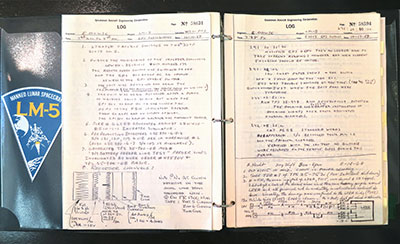 I built a spreadsheet from the data to look for patterns, and they generally maintained a pace of working Monday through Saturday. They did get a reprieve for the July 4 weekend, but then worked seven days a week from July 8 until July 27. And throughout, they rotated between day and night shifts on a weekly to biweekly basis. Neil Armstrong's lunar globe that he gave to his parents: 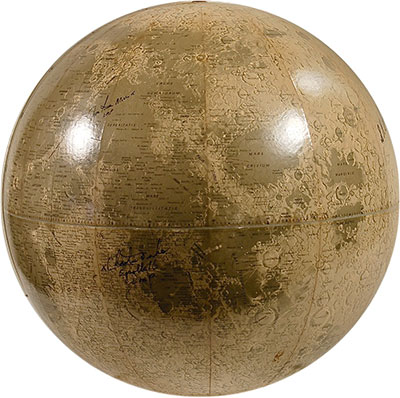 X-ray of his boots, 9 days before launch: 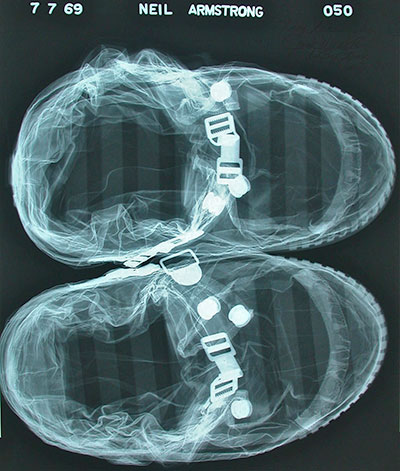 DSKY used in the CM Simulator: 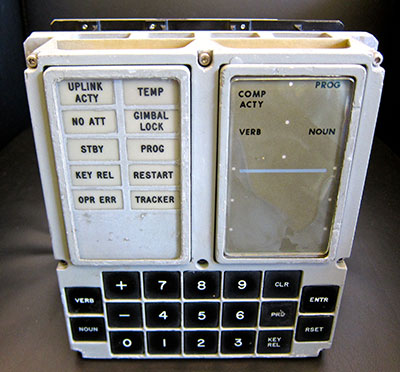 And docking model used in training: 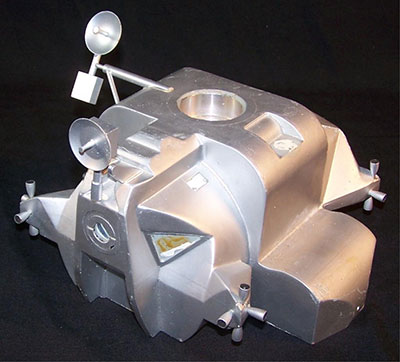 The typewritten bacon-rich menu for Neil Armstrong, which reminds me of a story when I met him and he told me he had nightmares of the ascent stage VPA for months before launch. And the prototype build of the first flag on the moon, as well as the Goodwill Disc: 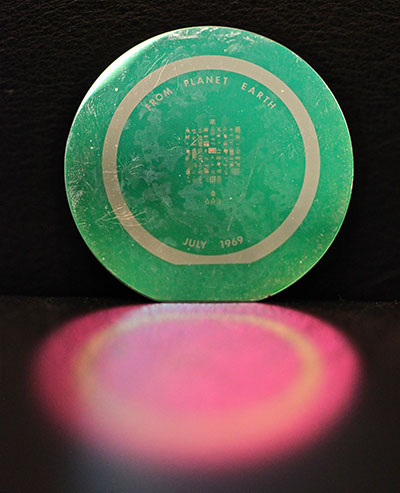 |
Jurvetson
Member Posts: 125
From: Los Altos an SF, CA, United States
Registered: Sep 2011
|
 posted 12-29-2012 01:51 AM
posted 12-29-2012 01:51 AM
   
I ran into a site hiccup, and ended up posting twice, and cannot delete this duplicate since I am not a forum leader, so let me edit it to show the Apollo 11 prototype flag build instead: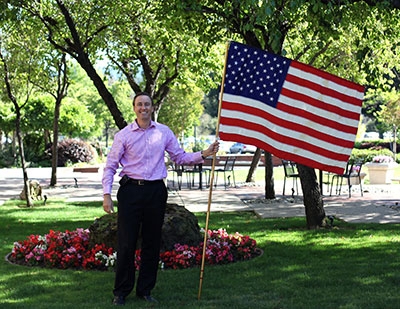 |
Philip
Member Posts: 6100
From: Brussels, Belgium
Registered: Jan 2001
|
 posted 12-29-2012 04:59 AM
posted 12-29-2012 04:59 AM
   
Superb pristine US flag! Wondering how the six US flags on the Moon look like these days... |
Robert Pearlman
Editor Posts: 46573
From: Houston, TX
Registered: Nov 1999
|
 posted 12-29-2012 06:31 AM
posted 12-29-2012 06:31 AM
   
Wonder no more (or at least, less more): Beyond a shadow of a doubt: US flags still standing at Apollo moon landing sites |
Jurvetson
Member Posts: 125
From: Los Altos an SF, CA, United States
Registered: Sep 2011
|
 posted 07-16-2014 10:02 PM
posted 07-16-2014 10:02 PM
   
For the 45th anniversary of the Apollo 11 launch, I posted a couple new additions:The EVA handle from Columbia that Larry asked about earlier on the thread. It finally resurfaced on eBay with a "Buy it Now" option: 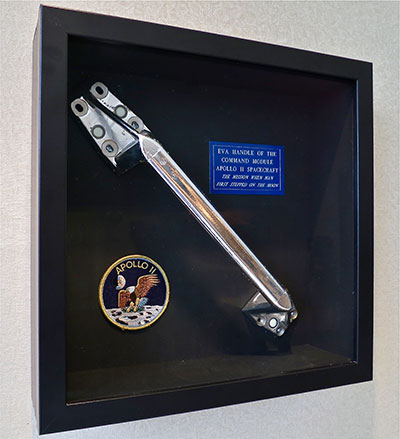 Having read this thread, would it be accurate to say that this is the only flown part of Columbia outside of the Smithsonian (besides Kapton foil)? Buzz's tribute to Michael Jackson.  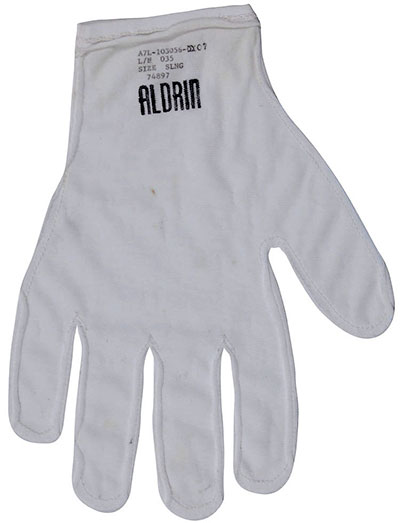 And I picked up a larger slice of the moon. |
Robert Pearlman
Editor Posts: 46573
From: Houston, TX
Registered: Nov 1999
|
 posted 07-16-2014 10:15 PM
posted 07-16-2014 10:15 PM
   
Congrats Steve, on the tremendous additions to your collection! That EVA handle has quite the history, beyond just traveling to the moon... quote:
Originally posted by Jurvetson:
...would it be accurate to say that this is the only flown part of Columbia outside of the Smithsonian?
Other than Kapton (as you've noted), Columbia's flown rotation hand controller was in private hands as of May 2013, when it was pulled from auction due to a NASA inquiry (the outcome of which has not been publicly reported, to my knowledge). |
SpaceAholic
Member Posts: 4885
From: Sierra Vista, Arizona
Registered: Nov 1999
|
 posted 07-16-2014 10:30 PM
posted 07-16-2014 10:30 PM
   
There are other structural components from Columbia in private hands as well. |
Ken Havekotte
Member Posts: 3257
From: Merritt Island, Florida, Brevard
Registered: Mar 2001
|
 posted 07-16-2014 11:14 PM
posted 07-16-2014 11:14 PM
   
What a fantastic EVA handle from CM-107, however, if not already discussed beforehand, don't forget about NASA-produced heat shield core segments from Spacecraft Columbia along with several of the smaller flown Apollo 11 command module heat shield ablative plugs.In addition, but seldom seen, are charred segment particles of 107's aft heat shield as well. |
mode1charlie
Member Posts: 1269
From: Honolulu, HI
Registered: Sep 2010
|
 posted 07-16-2014 11:47 PM
posted 07-16-2014 11:47 PM
   
Fantastic piece, Steve. What an object - with a story behind it - to have in one's collection. |
Jurvetson
Member Posts: 125
From: Los Altos an SF, CA, United States
Registered: Sep 2011
|
 posted 07-17-2014 11:38 AM
posted 07-17-2014 11:38 AM
   
Ah yes, heat shield and recovery material samples, and the rotational controller is particularly interesting. I am curious about that one and whether David Herskowitz, Butterfields' natural history specialist, knew of it in 2000 when he summarized the EVA handle: "In my opinion, it is the only legitimate Apollo 11 artifact that has been offered to the public." The use of the word "legitimate" intrigued me. I will try to ping him about that. Scott, a very intriguing reply. What structural elements, if you don't mind? I'd like to edit my Flickr post for accuracy. |






















